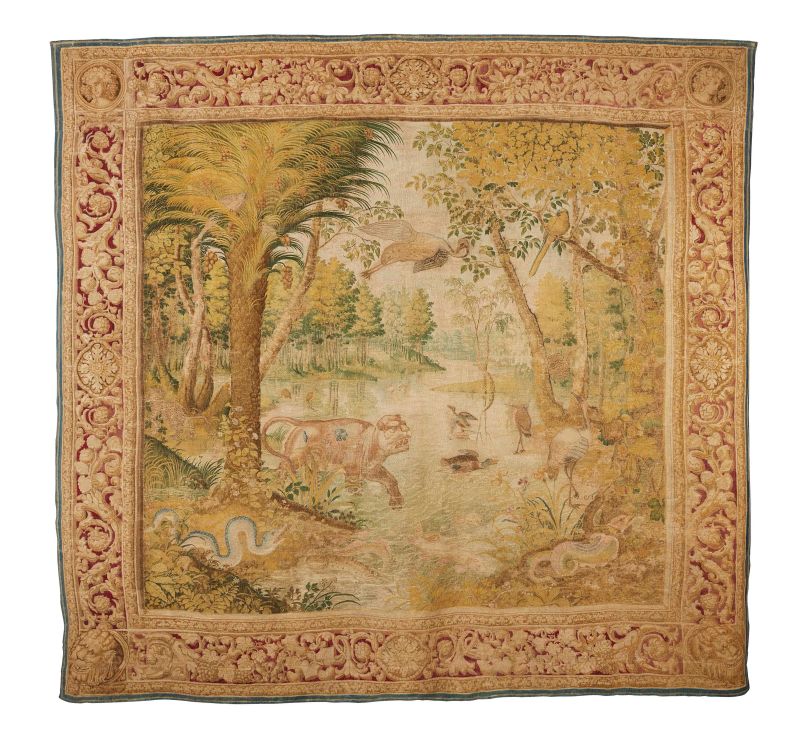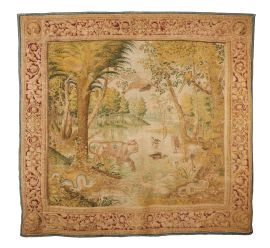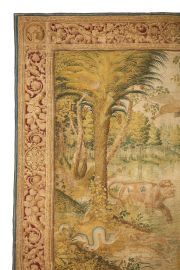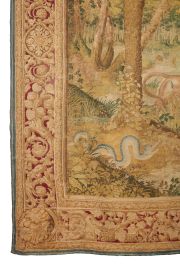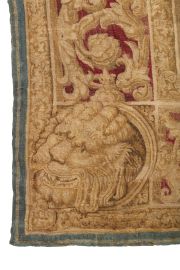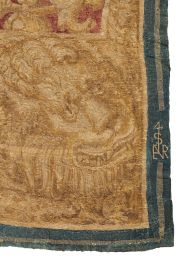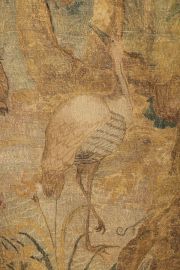Manufactory of Jan Raes the Elder
Manufactory of Jan Raes the Elder
(Brussels 1574-1651)
Cartoon by Jean II Tons (Brussels, c. 1500-1569/1570), c. 1550
LA LEONESSA NEL FIUME (LIONESS IN THE RIVER), 1611-1614
Tapestry. Warp: silk (9 threads/cm); weft: silk
478 cm wide x 445 high
Jan I Raes mark on the right selvedge
An export licence is available for this lot
Provenance
For the early history of tapestry and the series that had belonged to Cardinal Alessandro Peretti Montalto, Prince Michele Peretti Montalto, Cardinal Francesco Peretti Montalto and to Paolo Savelli in Rome, see below. Lastly, the Lioness in the River/ Leonessa nel fiume was in the hands of a Roman noble family.
References
Unpublished; but on the series of Landscapes with Animals, see: G. J. Hoogewerff, “Prelaten en Brusselsche tapijtwevers. III”, in Mededeelingen van het Nederlandsch Historisch Instituut te Rome, V, 1925, pp. 140, 144-148; N. Forti Grazzini, Paesaggio con cervo, Galleria Rabel, Montecarlo/San Marino 2004; P.-F. Bertrand, Les tapisseries des Barberini et la décoration d’intérieur dans la Rome baroque, Turnhout 2005, pp. 76, 230; N. Forti Grazzini, “Brussels Tapestries for Italian Customers: Cardinal Montalto’s Landscapes with Animals Made by Jan II Raes and Catherine van den Eynde”, in Cultural Exchange between the Netherlands and Italy (1400-1600), ed. by I. Alexander-Skipnes Turnhout 2007, pp. 239-266; N. Forti Grazzini, “Leopard over a Pond”, in Tapestry in the Baroque. Threads of Splendor, ed. by T. P. Campbell, exhibition catalogue, New York – New Haven/London 2007, pp. 87-94, n. 9; I. Jedzinskaitė-Kuizinienė, Lietuvos didžiosios kunigaikštystės valdovų rūmų gobelenai, Vilnius 2011, pp. 140-143.
This is a great masterpiece tapestry. Even though it is obscured by widespread losses of weft and faded colors; there are no modern repairs, it is well legible having been consolidated during a recent restoration and the colors on the upper half are quite vivid. It presents an exotic zoological scene set in a spectacular and realistically rendered landscape. A lioness is crossing a river, the ripples on the water create luminescence and reflections. The river, flowing between wooded banks is framed by plants and trees that include a date palm and an oak with parrots perched on their branches. On the left bank, a leopard is drawing away; up in the sky to the right are ducks and herons; in the foreground one snake is drinking, another is shedding its skin by going through the cavity of a root and an eel is writhing between the land and water. The border is decorated with gold foliate scrolls of artichokes, pomegranates and vines on a red ground, with heads of Bacchus and lions in the upper and lower corners, respectively. The image refers to zoological concepts handed down from Antiquity to the Middle Ages and to the Modern Era. Pliny the Elder (1) wrote that the lioness washes herself in water after mating with a leopard in order not to incur the wrath of the jealous lion; and in both the Greek and Latin versions of the Physiologus (2), describe how the serpent drinks after having rid himself of his poison and squeezes through a crack in a rock or tree to cast off its skin, as a metaphor of purification that the Christian needs to attain eternal salvation.
The up to now unknown tapestry is part of a an extraordinarily fine series Landscapes with Animals woven by the greatest early seventeenth-century weaver in Brussels, Jan Raes the Elder (Brussels, 1574-1651) (3), in collaboration with the workshop of Catherina van den Eynde’s (Brussels, known since 1613, d. in 1620/1629), for Cardinal Alessandro Peretti Montalto (1571-1623), nephew of Pope Sixtus V, Vice-Chancellor of the Church, and lavish Roman patron of the arts [fig. 1] (4). There is abundant documentation on the making of the series, in particular early seventeenth century letters from the apostolic nuncios to the cardinals in Rome containing information and tapestries and weavers in the Flemish capital. The nuncio, Guido Bentivoglio signed the contract with Raes for the execution of the series in Brussels on 17 December 1611 (5). On 19 July 1614 the set was finished and sent to Rome (“a parament of two rooms of new tapestries, not yet displayed with forest verdures and animals drawn from nature” - un paramento di due stanze di razzi nuovi, non già messi in mostra, di verdura boscareccia con animali ritrati dal naturale); Cardinal Montalto displayed it in the church of San Lorenzo in Damaso for the saint’s feast day (6), and then moved it to his magnificent home - Palazzo Termini, on the Esquiline Hill. Further information about the series, starting from the twelve cartoons Raes had and of which Montalto had him weave eleven in sizes suited to his needs, is contained in a letter from the nuncio Ascanio Gesualdi to cardinal Scipione Borghese (Montalto’s friend who had wanted to purchase a replica of the Landscapes) on 14 January 1617: Montalto had paid the high price of 28 florins for per square ell (1 ell = cm 70) for his very fine and all silk tapestry. Of the cartoons totaling 728 square ells he chose a series of 507 ells, trimming the widths, but not the heights of the scenes in order not to sacrifice the beautiful leafy branches in the upper parts of the compositions (7). When Montalto died in 1623, the series went to his brother, Prince Michele Peretti Montalto and in 1631, to the prince’s son, Cardinal Francesco Peretti Montalto. The 1655 inventory of the cardinal’s estate includes the still complete series (8). Then, again by descent, it went to his nephew Cardinal Paolo Savelli; the breakup of the still intact series began after Savelli’s death in 1685.
The other surviving tapestries of the series, in the same figurative style, of equal height and finished with the same borders are: Rhinoceros (475 x 505 cm, with by Raes with the Van den Eynde mark), in Italy until 1978, and since in a private collection in Belgium (9); Leopard over a Pond (467 x 587 cm; with the Van den Eynde mark) owned by the Sovereign Order of Malta in Palazzo Savelli Orsini, Rome (10); Ostriches (470 x 592 cm, with the Raes mark and signature) in the same collection (11); Stag (473 x 340 cm) in the Galleria Rabel, San Marino [fig. 2] (12); Dragon Eats the Eggs (455 x 315 cm) in the National Museum Palace of the Grand Dukes of Lithuania in Vilnius (13); Leopard Biting a Lion, divided into two parts that were sold on the market and are in unknown locations (14). There are other known but less sumptuous versions with different borders of the Landscapes with Animals by Raes, including a replica of the Lioness in the River (344 x 451 cm), that appeared at the Sotheby’s, Zurich sale, on 10 December 1996, lot 230, and was later in Florence, owned by Nathan Levi (15).
Eleven of the twelve cartoons of the Landscapes with Animals that Raes had were models for tapestries that had been painted around the middle of the sixteenth century and had already been used in Brussels to weave sets on that theme that was brought into fashion by the late fifteenth-century geographic discoveries, by renewed interest in non-European animals and Ancient and Medieval descriptions of them, as well as the trend in collecting exotic mirabilia that were put into the Wunderkammers of princes. The cartoons were probably done by Jean Tons II, a Flemish artist specialized in nature images who around 1530 had painted the landscape backgrounds and animals on the cartoons of the Hunts of Maximilan by Bernard van Orley (see the complete set of tapestries in the Louvre) and later designed the first animal series woven in Brussels. A sketch for a tapestry cartoon depicting a Landscape with Rhinoceros and Other Animals is in the British Museum, London (16). The two oldest Brussels series of Landscapes with Animals, from 1550-1560, are: one woven for Sigismund Augustus of Poland, in Wawel Castle, Krakow (17), and the one called Unicorn, woven perhaps for Cardinal Charles de Guise later property of Cardinal Mazarin, now in the Borromeo Collection at Isola Bella (Novara) on Lake Maggiore (18). It is this latter set that includes the oldest known version of the Lioness in the River (412 x 528) (19), enriched with gold weft threads, decorated with a border that includes Bible verses and moral mottos that must have prompted the viewer to interpret the animals as Christian symbols and ethical models [fig. 3] (20). It is probable that Cardinal Montalto admired the possible allegorical interpretation of his animal tapestries. According to Physiologus, the serpent drinking and that sheds its skin, as well as the lioness washing herself depicted in the tapestry presented here could have been interpreted as urging to moderation of the senses and purification, or as an allusion to the sacrament of baptism. But the cardinal who was also an enthusiastic student of zoology, must have admired the tapestry and the series it was part of also, or mainly, for the great naturalistic scenes. In fact, the cardinal owned the most important sixteenth-century books on zoology (by Gessner, Belon, Aldrovrandi) and he had decorations with animals painted in the Palazzo della Cancelleria and in Villa Lante at Bagnaia (21); he had placed statues of big exotic animals (leopards, tigers, rhinoceroses) in the gardens of Villa Termini (22); and in that same park he kept two caged lions that he fed with meat from Lazio buffalos (23).
Document 1
The Landscapes with Animals woven by Jan Raes for Cardinal Montalto and the cartoons for the series that the weaver had (including the one of “Lione nell’acqua” – Lion in Water), are mentioned in a 4 January 1617 letter written by the nuncio Ascanio Gesualdi in Brussels to Cardinal Scipione Borghese in Rome and in an attachment to the letter:
“…Raes has the drawings or patterns for the tapestries that were woven in silk for Cardinal Montalto, that consist of twelve landscapes with big animals, as your Illustrious Eminence will see from the bill for each piece enclosed as are the patterns […]. The price is stated to be 28 florins per ell, as it also appears on the contract prepared for Cardinal Montalto […]. Some of these twelve pieces can also be divided or decreased to make them suitable for the walls of the room where they will be. Therefore if your Illustrious Eminence will kindly advise [us] which pieces you would like to have decreased or divided, that [we] will ordered done as [we] did for the Cardinal, which however, are only 507 ells. It will take 15 months to make them, and the payment shall be made in the above manner in three installments …”
“Memorandum of the dimensions of the tapestries of big animals as they were made for Cardinal Montalto, all with their borders: the first of the Elephant 10 ells wide, 10 high. The second with the Leopard looking at its reflection, 9 ells h. The third of the Rhinoceros, 9 ells h. The fourth of the Lion in the water, 8 ells h. The fifth of the battle of the Leopard with the Unicorn, 9 ells h. The sixth, the Ostrich, 10 ells h. The seventh, where the Elephant goes to drink with the Unicorn, 9 ells h. The eighth, Leopard Biting a Lion, 7 ells h. The ninth, where the Dragon Eats the Eggs, 7 ells h. The tenth, battle of the Elephant with the Dragon, 11 ells h. The eleventh, of the Leopard and the monkeys, 8 ells h. The twelfth were the Dragon flies up to the tree, 6 ells h. With their borders they are all 104 ells wide. In all 728 [square] ells.”.
(from Hoogewerff, Prelaten…1925, pp. 145-148)
Document 2
The Landscapes with Animals of Cardinal Alessandro Montalto described in the inventory of his nephew Cardinal Francesco Montalto’s estate (Rome, Archivio di Stato, Archivio Notarile Urbano, sez. V, prot. 4, fs. 69, fols. 955-957, notary Simonelli, 30 May – 30 July 1655):
“Tapestries numbering eleven of silk in capicciola [a kind of silk] done with Woods, different animals that is elephants, lions, panthers, tigers, unicorn, dragons with yellow friezes all around with leaves and pomegranates and great roses in the middle [of each side], heads of Bacchus in the upper corners and heads of lions in the lower corners, they are 7 ells high about 76 ells long which is, for all of them, 532 [square] ells, I say 532 ells used”.
(from Bertrand, Les tapisseries…2005, p. 230)
1) Naturalis Historia, VIII, 17.
2) F. Zambon, ed., Bestiari tardoantichi e medievali. I testi fondamentali della zoologia sacra cristiana, Florence-Milan 2018, pp. 25, 143.
3) Important biographical information on this weaver who had previously been considered two figures (Jan I and Jan II Raes), is provided by K. Brosens, New Light on the Raes Workshop in Brussels and Rubens’s Achilles Series, and in Tapestry in the Baroque. New Aspects of Production and Patronage, ed. by T. P. Campbell, E. A. H. Cleland Conference Proceedings, New York – New Haven/London 2010, pp. 20-33.
4) Fond of music, owner of palazzos and villas, Montalto was a client of Rubens and Bernini, Lanfranco, Domenichino, Albani and Reni, and purchased many sets of tapestries, see B. Granata, Le passioni virtuose. Collezionismo e committenze artistiche a Roma del cardinale Alessandro Peretti Montalto (1571-1623), Rome 2012, with bibliography; on Montalto’s tapestries, see Forti Grazzini, Leopard…2007, pp. 92-93, with previous bibliography.
5) Hoogewerff, Prelaten…1925, p. 147, doc. IV.
6) Z. Waźbiński, Il cardinale Francesco Maria del Monte, 1549-1626, Florence 1994, II, pp. 362, 632.
7) Hoogewerff, Prelaten…1925, pp. 145-146.
8) Forti Grazzini, Leopard…2007, p. 87; for the description in the 1655 inventory, see Bertrand, Les tapisseries…2005, p. 230; Forti Grazzini, Brussels…2007, p. 262.
9) M. Roethlisberger, “La Tenture de la Licorne dans la Collection Borromée”, in Oud Holland, 82, 1967, p. 109, fig. 11 ; T. H. Clarke, The Rhinoceros from Dürer to Stubbs, 1515-1799, New York 1986, p. 85, fig. 86; Forti Grazzini, Leopard…2007, p. 90, fig. 43.
10) Forti Grazzini, Leopard…2007.
11) Forti Grazzini, Brussels…2007, p. 247, figs. 15-16.
12) Forti Grazzini, Paesaggio…2004.
13) Jedzinskaitė-Kuizinienė, Lietuvos…2011, pp. 140-143.
14) Roethlisberger, La Tenture…1967, p. 109.
15) Forti Grazzini, Brussels…2007, p. 248, fig. 18.
16) N. Forti Grazzini, “Verdures with animals”, Grand Design. Pieter Coecke van Aelst and Renaissance Tapestry, ed. by E. Cleland, exhibition catalogue, New York – New Haven/London 2014, pp. 338-341, fig. 243.
17) Ibid., pp. 336-345, with previous bibliography.
18) Roethlisberger, La Tenture…1967, pp. 85-115; M. Viale Ferrero, “Quelques nouvelles données sur les tapisseries de l’Isola Bella”, in Bulletin des Musées Royaux d’Art et d’Histoire, 45, 1973, pp. 77-142.
19) Ibid., pp. 77-81, fig. 1-2. There is a complete reproduction of the tapestry in C. Pezzana, Arazzi novaresi, Novara 1990, pp. 76-77.
20) Mercedes Viale Ferrero gave the subject the title “La natura originariamente buona” and sees it as a sort of Paradisiacal depiction that precedes the struggle between good and evil, with the final victory of the former, played out allegorically in the other panels of the set. This interpretation is forced and cannot be shared.
21) Granata, Le passioni…2012, pp. 70-73
22) C. Benocci, “Lo sviluppo seicentesco delle ville romane di età sistina: Il giardino della Villa Peretti Montalto e gli interventi nelle altre ville familiari del cardinale Alessandro Peretti Montalto, 1615 – fine sec. XVII”, in L’Urbe. Rivista romana, 56, n. 3, May-June 1996, p. 122.
23) Granata, Le passioni…2012, p. 73.

